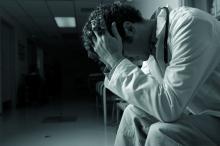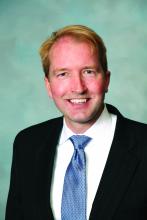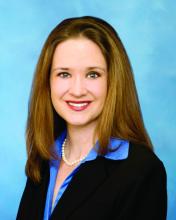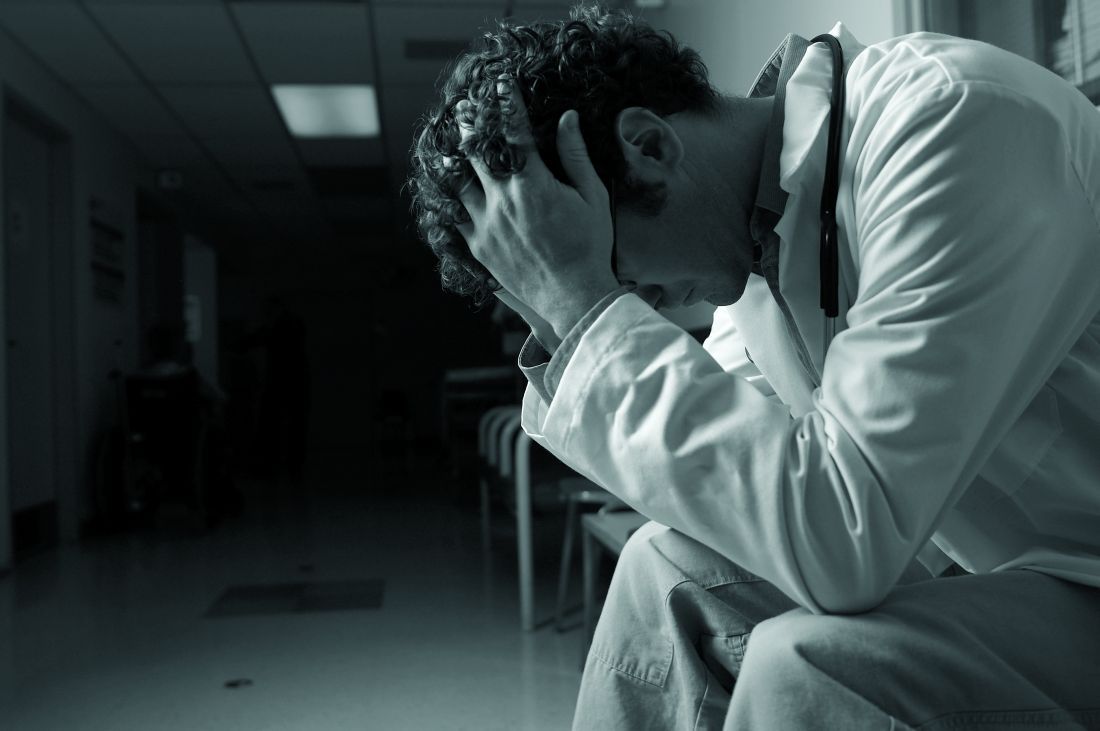User login
SPECIAL REPORT: SVS Takes Aim at Addressing Physician Burnout, Wellness
In my editorial in the November issue of Vascular Specialist I asked the question: Are we ok? I received many responses from members and I think the collective answer is best characterized as …maybe. Like nearly every other physician, I have witnessed the effects of burnout for my entire career. After high school, I enrolled in a BA/MD program with about 60 other students. Nearly half never matriculated. After medical school, I began a general surgery residency with seven other categorical interns. Six of them quit in the first year. What we now call burnout was once thought of as a process for weeding out those who could not “hack” it. Those students were not fit to be doctors; those interns were not fit to be surgeons. The process worked. Or so we thought.
The epidemic of physician burnout has raised alarm in many healthcare organizations. This mental state, characterized by emotional exhaustion, depersonalization and a diminished sense of personal accomplishment, has adverse consequences for both patient and clinician. The statistics are sobering. More than half of physicians, by self-report, have symptoms of burnout. No clinician is immune. Significant numbers of nurses and residents are similarly affected. The trend is worrisome. Compared to 2011, the percentage of physicians with burnout symptoms has increased, and the percentage satisfied with their work/life balance has decreased. Burnout affects physicians across all specialties, but the picture is particularly grim for surgeons, and even a bit more so for vascular surgeons. Compared with 13 other surgical specialties, vascular surgeons report the second highest rate of burnout. They also report the lowest level of career satisfaction, ranked first in stating they may have chosen an alternate career if they could choose again, and first in recommending an alternate career to medicine to their children.
In light of these sobering data, it must become an increasing concern of SVS as our professional home, as well as APDVS, as the professional home for Program Directors in Vascular Surgery, when almost a third of vascular surgeons report depression, and when compared to other surgical specialties, the highest incidence of suicidal ideation occurs in our own colleagues. Perhaps most importantly, 70 percent of physicians who score in the lower third on the Physician Well-Being Index report their well-being as average or above average. So relying on introspection offers limited hope.
Burnout is also a patient care-quality issue. Patients who are cared for by clinicians suffering from burnout do not fare well. A burned-out physician may appear to colleagues as frustrated, cynical and even callous, and to his or her patients as lacking empathy and compassion. Only 53 percent of patients, when surveyed, believe the health care system provides compassionate care. Diabetic patients of physicians with high empathy scores had improved control of HbA1c, fewer hospitalizations and fewer serious complications. Similarly, those with cancer had improved psychological adjustment, decreased ICU utilization and an improved immune response.
What does this landscape look like to those starting their medical careers – our future vascular surgeons? As a rule, students enter medical school altruistic and idealistic, excited about becoming a doctor, empathic and eager to care for their future patients. What follows is a decline in compassion, a crucial ingredient to mitigate burnout. Their curriculum focuses on emotional detachment and affective distancing for the purpose of clinical neutrality. Twenty percent of medical school graduates reported that they experienced disconnects between what they were taught about professional behaviors and attitudes and what they saw demonstrated by their faculty. Empathy is further eroded as residents experience “time-constrained” patient interactions in the clinic, the emergency department and the operating room. They often work with frustrated and overwhelmed faculty members who are experiencing increased pressure to generate greater clinical revenue and struggle with non-intuitive electronic medical record systems.
By almost any metric, vascular surgeons’ work is stressful. They work long hours, spend considerable hours in the operating room (average 20 hours a week) and average 2.7 nights of call a week. The vascular surgery workforce needs to continue to increase in light of the aging population that generally is sicker, yet demanding of more active lives. The demand will not be met without improving the health of our workforce.
Burnout also leads to early retirement. And burnout predicts the future. Each one-point change on the emotional exhaustion burnout scale is associated with a 43 percent higher likelihood that the affected physicians will reduce their FTE over the ensuing 24 months. Compounding supply further are the issues at the front end. An alarming 69 percent of U.S. general surgery trainees meet the criteria for burnout, and 44 percent of the 753 general surgery residents sampled considered dropping out of their training program; an even greater proportion considered doing so if they had symptoms of burnout. Women in training were at a higher risk of burnout compared to men. Although a study of burnout and job satisfaction in members of the American College of Surgeons found that private-practice surgeons were more likely to experience burnout than surgeons practicing in academic settings, Elmore et. al. observed that residents who planned to enter private practice reported higher levels of burnout.
In summary, burnout out is real and is impacting the health, well-being, and careers of vascular surgeons. Burnout places both the surgeon and the patient at risk for a poor outcome. Burnout influences medical student and resident career choices. Burnout can no longer be ignored – doing nothing is not an option.
Can the Society of Vascular Surgery do anything to improve the well-being of its members? We will begin that discussion next month.
*The authors extend their thanks and appreciation for the guidance, resources and support of Michael Goldberg, M.D., Scholar in Residence, Schwartz Center for Compassionate Care, Boston, Mass., and Clinical Professor of Orthopedics at Seattle Children’s Hospital..
In my editorial in the November issue of Vascular Specialist I asked the question: Are we ok? I received many responses from members and I think the collective answer is best characterized as …maybe. Like nearly every other physician, I have witnessed the effects of burnout for my entire career. After high school, I enrolled in a BA/MD program with about 60 other students. Nearly half never matriculated. After medical school, I began a general surgery residency with seven other categorical interns. Six of them quit in the first year. What we now call burnout was once thought of as a process for weeding out those who could not “hack” it. Those students were not fit to be doctors; those interns were not fit to be surgeons. The process worked. Or so we thought.
The epidemic of physician burnout has raised alarm in many healthcare organizations. This mental state, characterized by emotional exhaustion, depersonalization and a diminished sense of personal accomplishment, has adverse consequences for both patient and clinician. The statistics are sobering. More than half of physicians, by self-report, have symptoms of burnout. No clinician is immune. Significant numbers of nurses and residents are similarly affected. The trend is worrisome. Compared to 2011, the percentage of physicians with burnout symptoms has increased, and the percentage satisfied with their work/life balance has decreased. Burnout affects physicians across all specialties, but the picture is particularly grim for surgeons, and even a bit more so for vascular surgeons. Compared with 13 other surgical specialties, vascular surgeons report the second highest rate of burnout. They also report the lowest level of career satisfaction, ranked first in stating they may have chosen an alternate career if they could choose again, and first in recommending an alternate career to medicine to their children.
In light of these sobering data, it must become an increasing concern of SVS as our professional home, as well as APDVS, as the professional home for Program Directors in Vascular Surgery, when almost a third of vascular surgeons report depression, and when compared to other surgical specialties, the highest incidence of suicidal ideation occurs in our own colleagues. Perhaps most importantly, 70 percent of physicians who score in the lower third on the Physician Well-Being Index report their well-being as average or above average. So relying on introspection offers limited hope.
Burnout is also a patient care-quality issue. Patients who are cared for by clinicians suffering from burnout do not fare well. A burned-out physician may appear to colleagues as frustrated, cynical and even callous, and to his or her patients as lacking empathy and compassion. Only 53 percent of patients, when surveyed, believe the health care system provides compassionate care. Diabetic patients of physicians with high empathy scores had improved control of HbA1c, fewer hospitalizations and fewer serious complications. Similarly, those with cancer had improved psychological adjustment, decreased ICU utilization and an improved immune response.
What does this landscape look like to those starting their medical careers – our future vascular surgeons? As a rule, students enter medical school altruistic and idealistic, excited about becoming a doctor, empathic and eager to care for their future patients. What follows is a decline in compassion, a crucial ingredient to mitigate burnout. Their curriculum focuses on emotional detachment and affective distancing for the purpose of clinical neutrality. Twenty percent of medical school graduates reported that they experienced disconnects between what they were taught about professional behaviors and attitudes and what they saw demonstrated by their faculty. Empathy is further eroded as residents experience “time-constrained” patient interactions in the clinic, the emergency department and the operating room. They often work with frustrated and overwhelmed faculty members who are experiencing increased pressure to generate greater clinical revenue and struggle with non-intuitive electronic medical record systems.
By almost any metric, vascular surgeons’ work is stressful. They work long hours, spend considerable hours in the operating room (average 20 hours a week) and average 2.7 nights of call a week. The vascular surgery workforce needs to continue to increase in light of the aging population that generally is sicker, yet demanding of more active lives. The demand will not be met without improving the health of our workforce.
Burnout also leads to early retirement. And burnout predicts the future. Each one-point change on the emotional exhaustion burnout scale is associated with a 43 percent higher likelihood that the affected physicians will reduce their FTE over the ensuing 24 months. Compounding supply further are the issues at the front end. An alarming 69 percent of U.S. general surgery trainees meet the criteria for burnout, and 44 percent of the 753 general surgery residents sampled considered dropping out of their training program; an even greater proportion considered doing so if they had symptoms of burnout. Women in training were at a higher risk of burnout compared to men. Although a study of burnout and job satisfaction in members of the American College of Surgeons found that private-practice surgeons were more likely to experience burnout than surgeons practicing in academic settings, Elmore et. al. observed that residents who planned to enter private practice reported higher levels of burnout.
In summary, burnout out is real and is impacting the health, well-being, and careers of vascular surgeons. Burnout places both the surgeon and the patient at risk for a poor outcome. Burnout influences medical student and resident career choices. Burnout can no longer be ignored – doing nothing is not an option.
Can the Society of Vascular Surgery do anything to improve the well-being of its members? We will begin that discussion next month.
*The authors extend their thanks and appreciation for the guidance, resources and support of Michael Goldberg, M.D., Scholar in Residence, Schwartz Center for Compassionate Care, Boston, Mass., and Clinical Professor of Orthopedics at Seattle Children’s Hospital..
In my editorial in the November issue of Vascular Specialist I asked the question: Are we ok? I received many responses from members and I think the collective answer is best characterized as …maybe. Like nearly every other physician, I have witnessed the effects of burnout for my entire career. After high school, I enrolled in a BA/MD program with about 60 other students. Nearly half never matriculated. After medical school, I began a general surgery residency with seven other categorical interns. Six of them quit in the first year. What we now call burnout was once thought of as a process for weeding out those who could not “hack” it. Those students were not fit to be doctors; those interns were not fit to be surgeons. The process worked. Or so we thought.
The epidemic of physician burnout has raised alarm in many healthcare organizations. This mental state, characterized by emotional exhaustion, depersonalization and a diminished sense of personal accomplishment, has adverse consequences for both patient and clinician. The statistics are sobering. More than half of physicians, by self-report, have symptoms of burnout. No clinician is immune. Significant numbers of nurses and residents are similarly affected. The trend is worrisome. Compared to 2011, the percentage of physicians with burnout symptoms has increased, and the percentage satisfied with their work/life balance has decreased. Burnout affects physicians across all specialties, but the picture is particularly grim for surgeons, and even a bit more so for vascular surgeons. Compared with 13 other surgical specialties, vascular surgeons report the second highest rate of burnout. They also report the lowest level of career satisfaction, ranked first in stating they may have chosen an alternate career if they could choose again, and first in recommending an alternate career to medicine to their children.
In light of these sobering data, it must become an increasing concern of SVS as our professional home, as well as APDVS, as the professional home for Program Directors in Vascular Surgery, when almost a third of vascular surgeons report depression, and when compared to other surgical specialties, the highest incidence of suicidal ideation occurs in our own colleagues. Perhaps most importantly, 70 percent of physicians who score in the lower third on the Physician Well-Being Index report their well-being as average or above average. So relying on introspection offers limited hope.
Burnout is also a patient care-quality issue. Patients who are cared for by clinicians suffering from burnout do not fare well. A burned-out physician may appear to colleagues as frustrated, cynical and even callous, and to his or her patients as lacking empathy and compassion. Only 53 percent of patients, when surveyed, believe the health care system provides compassionate care. Diabetic patients of physicians with high empathy scores had improved control of HbA1c, fewer hospitalizations and fewer serious complications. Similarly, those with cancer had improved psychological adjustment, decreased ICU utilization and an improved immune response.
What does this landscape look like to those starting their medical careers – our future vascular surgeons? As a rule, students enter medical school altruistic and idealistic, excited about becoming a doctor, empathic and eager to care for their future patients. What follows is a decline in compassion, a crucial ingredient to mitigate burnout. Their curriculum focuses on emotional detachment and affective distancing for the purpose of clinical neutrality. Twenty percent of medical school graduates reported that they experienced disconnects between what they were taught about professional behaviors and attitudes and what they saw demonstrated by their faculty. Empathy is further eroded as residents experience “time-constrained” patient interactions in the clinic, the emergency department and the operating room. They often work with frustrated and overwhelmed faculty members who are experiencing increased pressure to generate greater clinical revenue and struggle with non-intuitive electronic medical record systems.
By almost any metric, vascular surgeons’ work is stressful. They work long hours, spend considerable hours in the operating room (average 20 hours a week) and average 2.7 nights of call a week. The vascular surgery workforce needs to continue to increase in light of the aging population that generally is sicker, yet demanding of more active lives. The demand will not be met without improving the health of our workforce.
Burnout also leads to early retirement. And burnout predicts the future. Each one-point change on the emotional exhaustion burnout scale is associated with a 43 percent higher likelihood that the affected physicians will reduce their FTE over the ensuing 24 months. Compounding supply further are the issues at the front end. An alarming 69 percent of U.S. general surgery trainees meet the criteria for burnout, and 44 percent of the 753 general surgery residents sampled considered dropping out of their training program; an even greater proportion considered doing so if they had symptoms of burnout. Women in training were at a higher risk of burnout compared to men. Although a study of burnout and job satisfaction in members of the American College of Surgeons found that private-practice surgeons were more likely to experience burnout than surgeons practicing in academic settings, Elmore et. al. observed that residents who planned to enter private practice reported higher levels of burnout.
In summary, burnout out is real and is impacting the health, well-being, and careers of vascular surgeons. Burnout places both the surgeon and the patient at risk for a poor outcome. Burnout influences medical student and resident career choices. Burnout can no longer be ignored – doing nothing is not an option.
Can the Society of Vascular Surgery do anything to improve the well-being of its members? We will begin that discussion next month.
*The authors extend their thanks and appreciation for the guidance, resources and support of Michael Goldberg, M.D., Scholar in Residence, Schwartz Center for Compassionate Care, Boston, Mass., and Clinical Professor of Orthopedics at Seattle Children’s Hospital..



